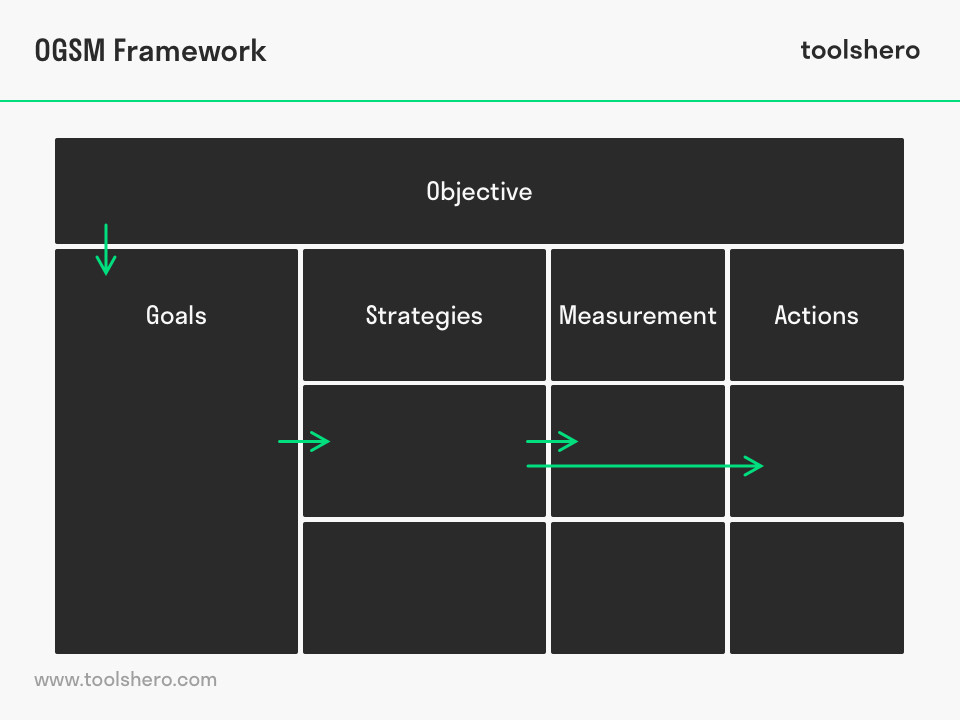OGSM Framework explained

OGSM Framework: this article provides a practical explanation of the OGSM Framework. The tool was popularised by Proctor & Gamble, and can be applied to an entire organisation, but also to a person’s personal development. This article covers what the OGSM Framework is and what its different elements are. It furthermore offers a step-by-step plan to create a personal strategic plan and an overview of the advantages and disadvantages of this Framework. It also contains a downloadable and editable OGSM Framework template. After reading, you’ll understand the basics of this strategy tool.
What is the OGSM Framework?
The OGSM Framework is a tool for operational planning that enables organisations to link their long-term vision to the right strategies.
The acronym OGSM stands for objective, goals, strategies and measurements (Key Performance Indicators).
These four elements ensure that the focus is divided and that concrete and measurable goals are established that support the strategy. In this way, the OGSM Framework helps to monitor the progress to the objectives and, if necessary, adjust.
The framework was developed to identify strategic priorities, quickly utilise market opportunities, optimise the use of resources, increase efficiency, and align parties with each other.
When used correctly, OGSM offers a succinct document, and a clear framework for developing, balancing and implementing a strategic plan for the medium-long term.
After strategic elements, such as the mission statement and vision, have been merged with operational elements, such as objectives and strategies, the result is an extensive but practical strategic plan of one sheet of paper. The OGSM Framework can be applied to the entire organisation, a department or team, and is also valuable for managing personal objectives.
The OGSM Framework was developed in Japan, in the ’50s of the previous century. It was subsequently brought from Japan to the United States and adopted by lots of large companies.
Particularly Proctor & Gamble embraced this model and used the framework to align the course of the multinational company. They are therefore credited with developing the modern version of the OGSM Framework.
Strategic and Operational Business Elements
The OGSM Framework serves as the basis for Strategic Planning and execution, in combination with an effective management routine. It ensures that the managers are aligned with the company’s SMART Goals and connects important strategies to financial objectives.
As a result, this creates transparency and visibility of the company’s capacities.

Figure 1 – The OGSM strategy Framework explained.
Objective
The start of this Framework is linked to the big picture of the organisation. What does the organisation want to achieve, and when?
The strategy is often established from higher management, and the objective must match this. Read more about the mission statement and vision here.
A clear vision for the company is important because it leads to:
- Integration between organisation and the outside world / departments;
- Be decisive for the (de)centralisation of authority;
- Coordinating;
- Motivation;
- Planning.
Example: company X must become the biggest player in industry Y.
Goals
The strategic goals are specific financial and non-financial goals and results an organisation seeks to achieve during a specific period.
The goals form the second of the four elements a company must phrase as part of the OGSM Framework. It’s crucial that the drafted goals are quantifiable. One way to ensure this is to use SMART goals. Strategic goals are important because:
- Stimulate priorities;
- Make the allocation of resources more efficient;
- Lead to better budget plans;
- They function as an important communication medium;
- Serve as the basis for a SWOT analysis.
Example: to become the biggest player in industry Y, company X must have a market share of 34% and achieve a turnover of 80 million euros before the end of the financial year. Or: company X must be active in at least three new markets before the end of the financial year.
Strategies
If the organisation’s objective and goals are clear, the next step is to think about a way to realise the goals. The strategy element from the OGSM Framework serves this purpose. The strategies are phrased in short and clear sentences that describe ways in which the organisation or department brings the organisation’s final goal closer.
Example: a larger market can be reached through logistic optimisation.
Measurement
The last element from the OGSM Framework is developing a measurement plan to measure the planned successes and developments. It’s important that the drafted goals are quantifiable. Although objectives cannot always be measured in hard numbers, matters such as quality, planning and deadlines can be measured somewhat.
Tactical action points
If it must be concluded that the strategy is not working by keeping track of the measurements, it must be adjusted. The tactical action points that achieve this are added to the last column of the OGSM Framework.
If the higher sales figures are not achieved, despite optimization of logistics networks, it may be necessary to optimize in other areas. Tactical action points ensure that the organization adjusts its strategy so that the objectives will be achieved in the future.
Step-by-step plan OGSM Framework
Executing the strategic planning process by means of the OGSM Framework isn’t difficult. Follow the steps below to make a personal strategic plan, or a strategic plan for your company.
1. Determine the objective
The first element of the OGSM Framework is to understand the strategy, mission and vision of your organisation. What does the organisation aim to achieve? And how? Use knowledge from the Strategic Planning article to draw up an accurate and succinct statement of the organisation’s objective.
2. Determine the goals
The next step in this framework is determining goals. It’s important that your goals are SMART. Particularly the quantifiability of goals is important: they must be measurable. Generally, companies formulate three or four goals.
Use Locke’s Goal Setting Theory for information about formulating goals.
3. Determine the strategies
When the objective and goals have been composed, the next step is to describe how the goals will be realised. Strategies are used for this purpose. It’s important that a strategy is determined for each of the goals.
4. Start monitoring and measuring
The goal of the OGSM Framework is to make it easier for management to track progress on the road to ambitious objectives. Progress can only be measured when it has been determined in advance how it will be monitored.
Monitoring progress answers the question; do our strategies work? And, will we achieve our goals? Should the objectives be adjusted?
An excellent tool to track progress is the Balanced Scorecard. The Balanced Scorecard offers various Key Performance Indicators (KPIs) to measure progress.
Advantages and disadvantages of the OSGM Framework
The use of the OGSM Framework has several advantages and disadvantages.
Advantages OGSM Framework
- Succinct method (1 A4 for better viability and monitoring progress);
- Goals are linked to concrete business activities;
- Goals are formulated based on realistic expectations;
- OGSM Framework encourages long-term planning;
- Identifies potential shortage in capacity.
Disadvantages OGSM Framework
- Powerful leadership is necessary for the execution
- Stakeholders need time to discuss and approve of the objectives
- Focus and speed are essential (allocation of resources in fast-changing environments)
Summary OGSM Framework
The acronym OGSM stands for: objective, goals, strategies and measurements. The OGSM Framework is the basis for strategic planning, and is used by many large companies, such as Proctor & Gamble.
By using OGSM, important strategies are linked to financial objectives. By continuing to use OGSM, the organisation’s capacities become visible through time, and the strategic main elements can be adjusted if necessary.
The objective from the OGSM Framework refers to the bigger picture and answers the questions, where are we going?
The goals are financial and non-financial objectives the organisation aims to achieve, and the strategies described how exactly these SMART goals will be reached. It’s important that the established drafted goals are measurable. Only then can progress be measured.
OGSM Framework template
Use this OGSM Framework template to create a succinct document, and a clear framework for developing, balancing and implementing a strategic plan.
Download the OGSM Framework template
This template is exclusively for our paying Toolshero members. Click here to see if a membership is something for you!Now It’s Your Turn
What do you think? Are you familiar with the explanation of the OGSM Framework? Do you see similarities with other strategic planning tools? What else is essential when drafting a strategic plan? Which pros do you see in this ‘business plan of 1 A4’? Do you have any tips or additional comments?
Share your experience and knowledge in the comments box below.
More information
- Kaplan, R. S., & Norton, D. P. (1996). Using the balanced scorecard as a strategic management system.
- Pearce, J. A., Robinson, R. B., & Subramanian, R. (2000). Strategic management: Formulation, implementation, and control. Columbus, OH: Irwin/McGraw-Hill.
- Riccaboni, A., & Luisa Leone, E. (2010). Implementing strategies through management control systems: the case of sustainability. International Journal of Productivity and Performance Management, 59(2), 130-144.
- Teece, D. J., Pisano, G., & Shuen, A. (1997). Dynamic capabilities and strategic management. Strategic management journal, 18(7), 509-533.
How to cite this article:
Janse, B. (2019). OGSM Framework. Retrieved [insert date] from Toolshero: https://www.toolshero.com/strategy/ogsm-framework/
Original publication date: 12/20/2019 | Last update: 08/23/2023
Add a link to this page on your website:
<a href=”https://www.toolshero.com/strategy/ogsm-framework/”>Toolshero: OGSM Framework</a>












